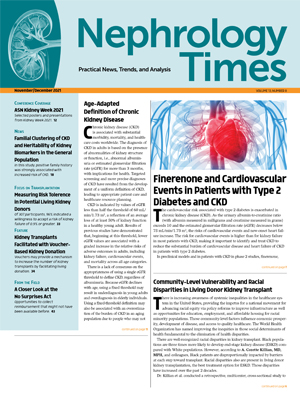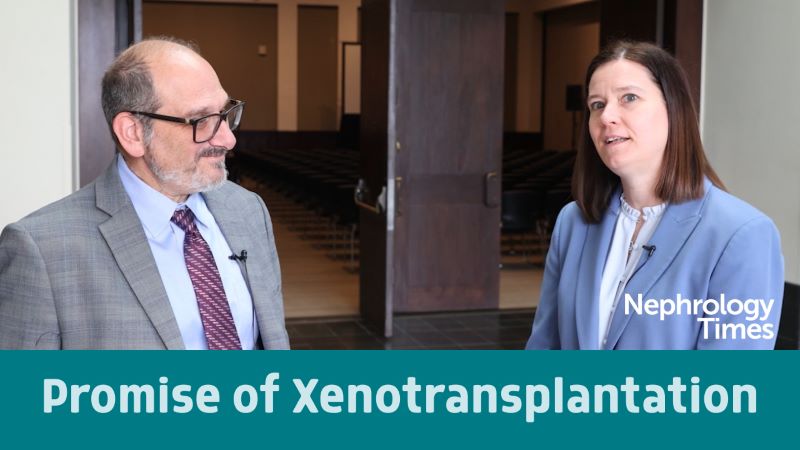
There is increasing awareness of systemic inequalities in the healthcare system in the United States, providing the impetus for a national movement for advancing racial equity via policy reforms to improve infrastructure as well as opportunities for education, employment, and affordable housing for racial minority populations. Those community-level factors influence economic prosperity, development of disease, and access to quality healthcare. The World Health Organization has named improving the inequities in those social determinants of health fundamental to the elimination of health disparities.
There are well-recognized racial disparities in kidney transplant. Black populations are three times more likely to develop end-stage kidney disease (ESKD) compared with White populations. However, according to A. Cozette Killian, MD, MPH, and colleagues, Black patients are disproportionally impacted by barriers at each step toward transplant. Racial disparities also are present in living donor kidney transplantation, the best treatment option for ESKD. Those disparities have increased over the past 2 decades.
Dr. Killian et al. conducted a retrospective, multicenter, cross-sectional study to examine whether racial disparities persist in living donor kidney transplant independent of community-level vulnerability. Results were reported online in JAMA Surgery [doi:10.1001/jamasurg.2021.4410].
Study exposures were recipient race and the 2018 US Centers for Disease Control and Prevention (CDC) Social Vulnerability Index (SVI). Census-tract-level SVI data were linked to census tracts within each recipient zip code. Community-level vulnerability was described using the median SVI measure among the census tracts within a zip code. The primary outcomes and measures were kidney transplant donor type (deceased vs living). The association between SVI and living donor kidney transplant was evaluated using modified Poisson regression. The researchers also estimated the likelihood of living donor kidney transplant among races, independent of community-level vulnerability and recipient-level characteristics.
The study included 19,287 adult kidney only transplant recipients; of those, 32% (n=6080) received a living donor kidney transplant. All comparisons between the group of living donor transplant recipients and deceased donor transplant recipients were statistically significant. Living donor recipients were younger (median 52 years vs 55 years) and more often male (63% vs 59%). Overall, the transplant recipients were primarily White, but a larger proportion of living donor recipients were White (80% vs 56%), while smaller proportions were Black (13% vs 34%) or of other races (8% vs 11%).
A greater percentage of living donor recipients received a preemptive transplant (33% vs 8%) or had fewer median years receiving dialysis compared with deceased donor recipients (0.6 years vs 4.0 years). More living donor recipients were working for income and had greater than a high school education compared with deceased donor recipients (48% vs 25% and 66% vs 50%, respectively). White living donor recipients were living in less vulnerable communities than Black recipients (SVI, 0.4 vs 0.6).
In analyses adjusted for recipient-level characteristics, there was an association between higher SVI and 3% lower likelihood of living donor kidney transplant (adjusted relative risk [aRR], 0.97; 95% confidence interval [CI], 0.96-0.98; P<.001). Recipients living in communities with SVI similar to the 10457 zip code (Bronx, NY) had 26% lower likelihood of living donor kidney transplant than recipients in communities with SVI similar to the 90210 zip code (Beverly Hills, CA) (aRR, 0.74; 95% CI, 0.69-0.80; P<.001).
In unadjusted analyses for race, the likelihood of living donor kidney transplant was 64% lower in Black recipients than in White recipients (RR, 0.36; 95% CI, 0.34-0.39; P<.001) and 38% lower in recipients of other races than in White recipients (RR, 0.62; 95% CI, 0.57-0.67; P<.001). Following adjustment for recipient-level characteristics and community-level vulnerability, Black recipients had a 37% lower likelihood of living donor kidney transplant (aRR, 0.63; 95% CI, 0.59-0.67; P<.001) and recipients of other races had 24% lower likelihood of living donor kidney transplant (aRR, 0.76; 95% CI, 0.70-0.82; P<.001) compared with White recipients.
In a fully adjusted model, there was a significant association with the interaction between SVI and race and living donor kidney transplant. While Black recipients and recipients of other races demonstrated lower likelihood of living donor kidney transplant (aRR 0.78; 95% CI, 0.67-0.90; P<.001 and aRR, 0.74; 95% CI, 0.63-0.86; P<001, respectively) compared with White counterparts (P for interaction=.01), only the interaction between SVI and Black recipients was significantly associated with living donor kidney transplant (ratio of aRRs, 0.67; 95% CI, 0.51-0.87; P=.003). Black recipients in zip codes similar to 90210 had 24% lower likelihood of living donor kidney transplant (aRR, 0.76; 95% CI, 0.66-0.86; P<.001), while Black recipients in zip codes with SVI similar to the 10457 zip code had 48% lower likelihood of living donor kidney transplant (aRR, 0.52; 95% CI, 0.45-0.60; P<.001) compared with White counterparts.
The authors cited some limitations to the study finding: SVI may not account for other neighborhood-level determinants of health that impact access to living donor kidney transplant; the unavoidable inaccuracies in census tract-level data aggregated to the zip code level; and the retrospective study design.
In conclusion, the researchers said, “In this study of kidney transplant recipients, the CDC SVI allowed for the most comprehensive evaluation of community-level vulnerability on disparate access to living donor kidney transplant to date. While greater community-level vulnerability was associated with lower likelihood of living donor kidney transplant, accounting for this only partially explained living donor kidney transplant racial disparities. Even among recipients in the least vulnerable US communities, recipients from racial minority groups were less likely to receive living donor kidney transplant. Importantly, the negative effects of living in a more vulnerable community were worse for Black patients. Thus, while policy reform is needed to improve disparate social determinants of health, evaluation of other factors that may impact access to living donor kidney transplant among racial minority populations is warranted.”
Takeaway Points
- Racial disparities in living donor kidney transplant have increased over the last 20 years. Researchers conducted a study to determine whether racial disparities persist in living donor kidney transplant independent of community-level vulnerability.
- Recipients who lived in more vulnerable communities had lower likelihood of living donor kidney transplant compared with those who lived in less vulnerable communities.
- Community-level vulnerability was associated with access to living donor kidney transplant, but only partially explained racial disparities in living donor transplant. The adverse effects of living in more vulnerable communities were worse for Black recipients.







 © 2025 Mashup Media, LLC, a Formedics Property. All Rights Reserved.
© 2025 Mashup Media, LLC, a Formedics Property. All Rights Reserved.